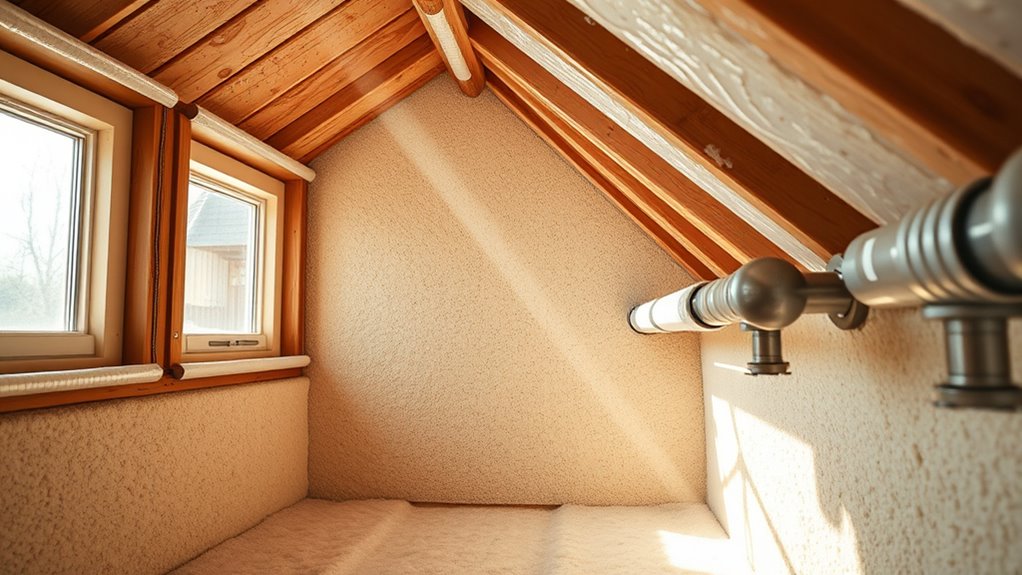Start by identifying common drafts around windows, doors, and electrical outlets using simple inspection tools or smoke pens. Seal leaks with weatherstripping, caulk, or foam sealants, focusing on areas like window frames and door thresholds. Upgrade insulation in your attic, walls, and floors to prevent heat loss, and consider energy-efficient windows with proper seals. Incorporate smart technology and develop a long-term maintenance plan to keep your home warm and efficient—more tips await to help you become confident in your fixes.
Key Takeaways
- Conduct thorough energy audits using inspection tools and thermal imaging to identify hidden drafts and heat leaks.
- Seal gaps around windows, doors, outlets, and vents with weatherstripping, caulk, and foam to prevent heat loss and drafts.
- Improve insulation in attic, walls, and floors, ensuring proper installation and moisture control for maximum efficiency.
- Upgrade to energy-efficient windows and doors with low U-values, plus maintain seals regularly for optimal performance.
- Incorporate smart thermostats, automated shading, and proper ventilation to optimize climate control and reduce energy costs.
Identifying Common Sources of Drafts and Heat Loss
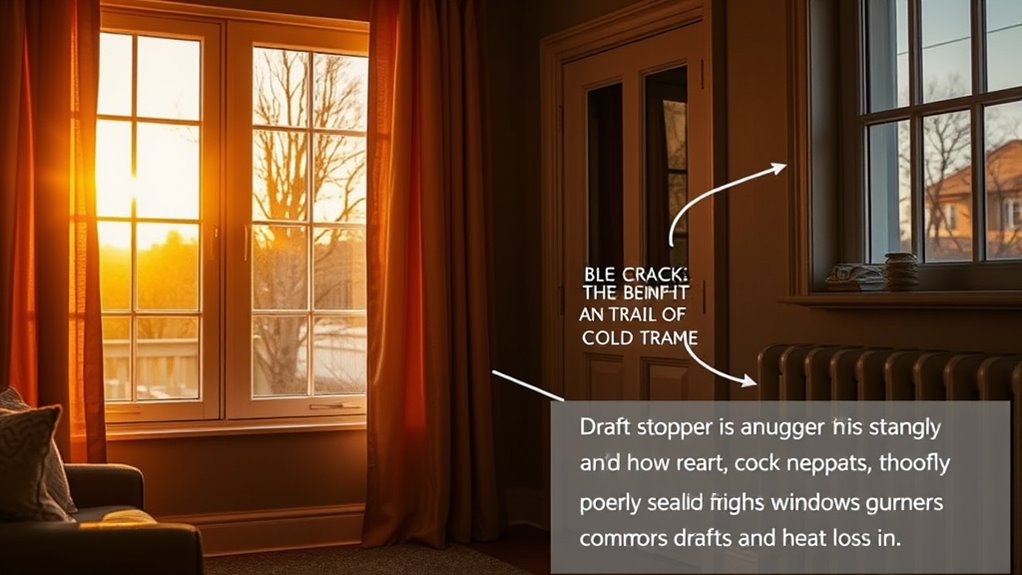
Understanding where drafts and heat loss originate is crucial for effective energy savings. You might notice drafty rooms, especially near windows and doors, where air leaks are common. Hidden drafts often lurk around electrical outlets, light switches, or in gaps along window frames. These small leaks can greatly impact your home’s warmth and increase heating costs. Drafts aren’t always obvious, so it’s essential to be vigilant. Cold air sneaking in or warm air escaping can make your living space uncomfortable and inefficient. Identifying these sources early helps you target the right fixes. Sealing leaks around windows, doors, and other areas can significantly reduce energy loss. By paying attention to areas that feel cooler or drafty, you can locate hidden drafts and take steps to seal them effectively, enhancing your home’s energy efficiency.
Conducting a Home Energy Audit to Pinpoint Problem Areas
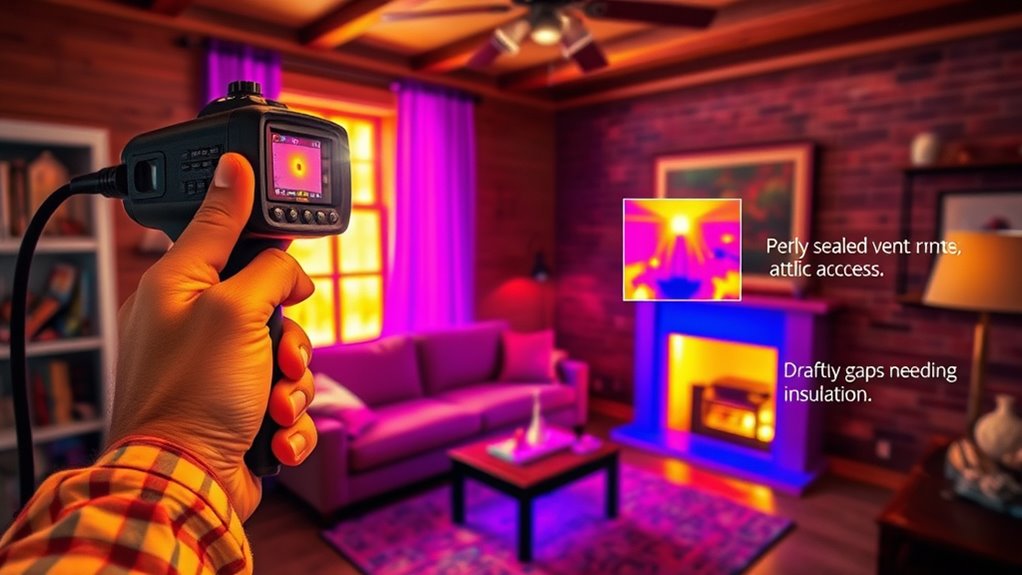
Start your home energy audit by carefully checking for air leaks around windows, doors, and vents. Then, evaluate your insulation levels to see if they meet recommended standards. Identifying these problem areas helps you target your fixes effectively. Incorporating insights from advanced AI-powered tools can further enhance the accuracy of your assessment.
Identify Air Leaks
To effectively identify air leaks in your home, you need to conduct a thorough energy audit. Start by inspecting common problem areas like windows, doors, electrical outlets, and gaps around pipes or vents. Use air leak detection tools such as smoke pens or flashlight tests during windy days to spot drafts. Seal visible gaps with weatherstripping or caulk to prevent drafts from entering. Pay attention to areas where warm air escapes and cold air sneaks in. Proper draft prevention not only improves comfort but also reduces heating costs. Remember, small leaks can have a big impact on heat loss. Conducting a comprehensive assessment helps you systematically identify and seal these leaks, creating a more energy-efficient home and set a solid foundation for further heat and wind loss fixes.
Assess Insulation Levels
Conducting a home energy audit is essential for pinpointing insulation deficiencies that contribute to heat loss. To assess insulation levels effectively, you need to evaluate how well your insulation materials maintain thermal comfort. This helps identify areas where heat escapes or cold enters, causing discomfort and energy waste. Incorporating thermal imaging can further enhance the accuracy of your assessment by revealing hidden cold spots. Consider these key points:
- Check attic and wall insulation for gaps or compression
- Look for signs of moisture or mold that compromise insulation performance
- Use thermal imaging to spot cold spots and heat leaks
- Review existing insulation R-values against recommended standards
- Ensure proper sealing around electrical outlets and vents
Basic DIY Sealing Techniques for Windows and Doors
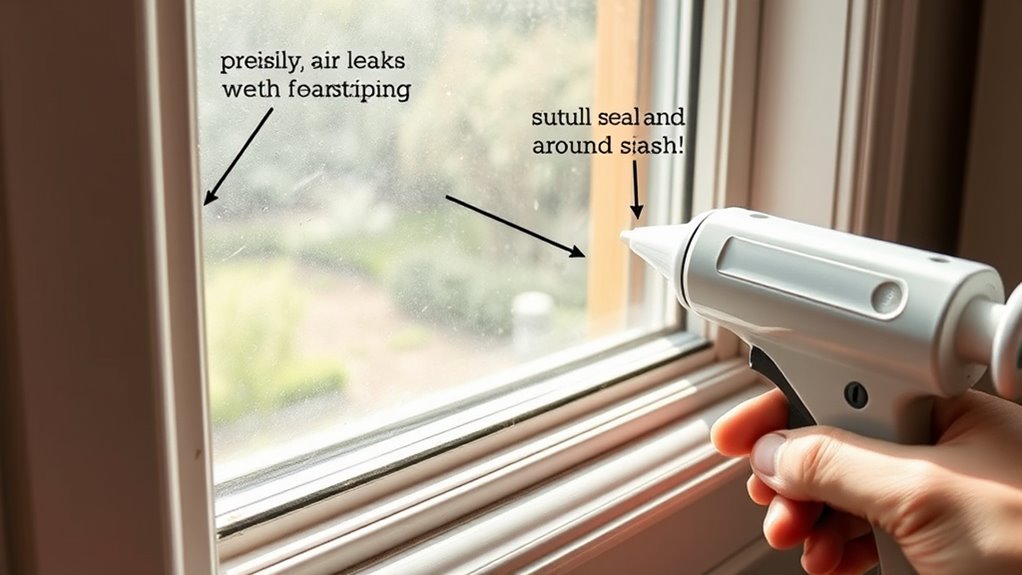
Are drafts and cold spots making your home less comfortable? You can improve your space with simple DIY sealing techniques for windows and doors. Start by inspecting gaps around frames and applying weatherstripping or adhesive-backed foam tape to seal leaks. For larger openings, consider using draft stoppers or door sweeps. DIY window treatments like thermal curtains and curtain insulation techniques can also help reduce heat loss, especially at night. These treatments trap air and create an extra barrier against cold drafts. Regularly checking and maintaining these seals guarantees they stay effective. Additionally, understanding how contrast ratio impacts image quality can help you select the right home theater projector for your needs. With a few basic tools and materials, you can substantially improve your home’s comfort and energy efficiency without professional help. Small adjustments make a big difference in reducing wind and heat loss.
Upgrading Insulation in Attics, Walls, and Floors
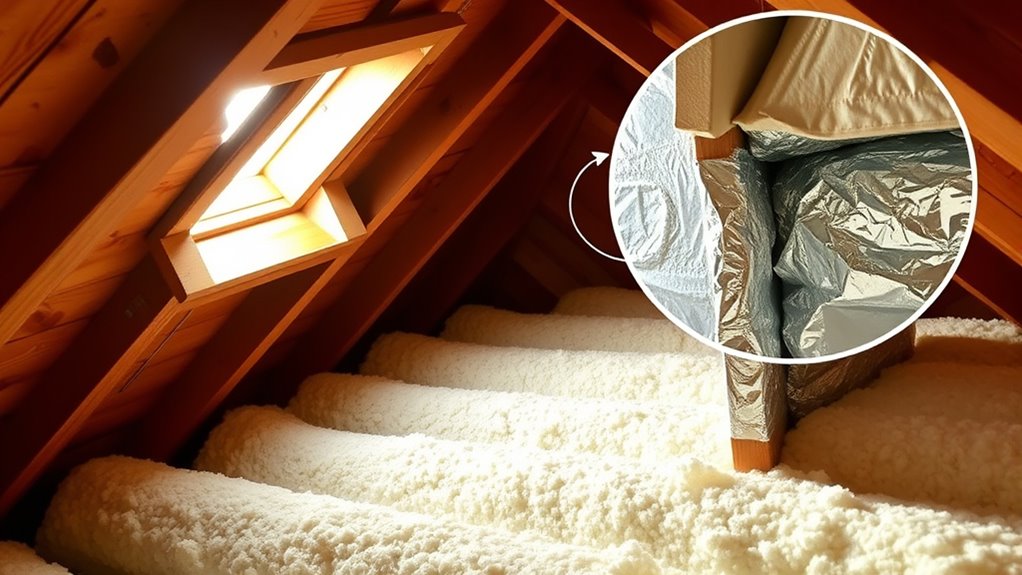
After sealing gaps around windows and doors, upgrading your insulation can further improve your home’s energy efficiency. Proper insulation reduces heat transfer through thermal bridging and minimizes heat loss in winter while keeping your home cooler in summer. When upgrading, consider adding insulation to attics, walls, and floors for thorough coverage. Use vapor barriers where appropriate to prevent moisture buildup, which can compromise insulation effectiveness. Focus on reducing thermal bridging by installing continuous insulation layers and insulating around framing. Additionally, ensure proper ventilation to prevent moisture problems. Remember, a well-insulated home not only saves energy but also enhances comfort and indoor air quality. To maintain optimal performance, regularly check your Ring Security Cameras for any issues that might affect your home’s security and energy efficiency.
Choosing the Right Weatherstripping and Sealants
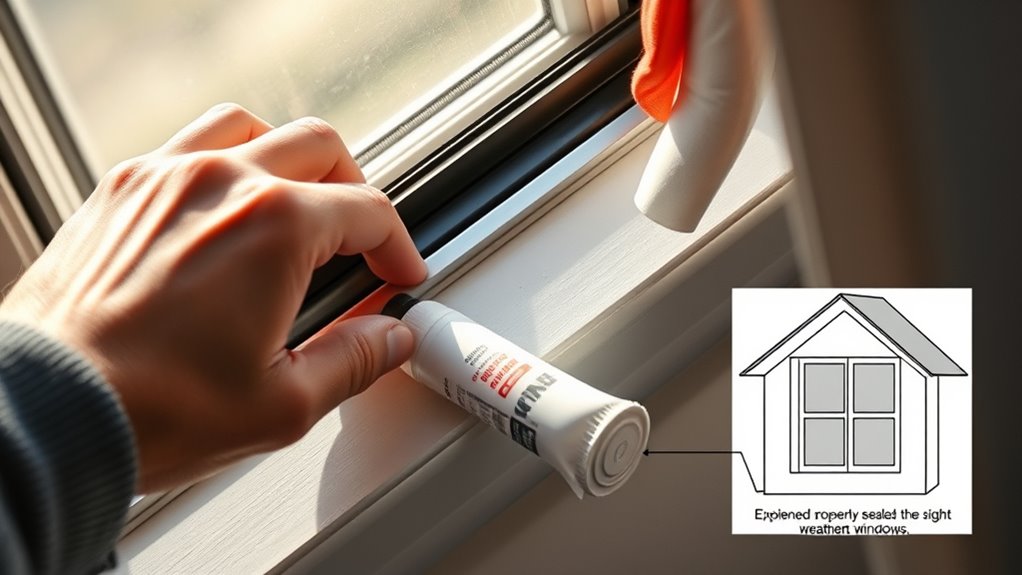
Choosing the right weatherstripping and sealants is essential for preventing air leaks and maximizing your home’s energy efficiency. When selecting weatherstripping options, consider factors like durability, ease of installation, and compatibility with your doors and windows. Common options include foam tape, V-strip, and rubber gaskets. For sealant types, decide between caulk, foam, or weatherproof paint, depending on the gap size and material. Caulk works well for small cracks around window frames, while foam sealants fill larger gaps effectively. Properly choosing and applying these materials guarantees a tight seal, reduces drafts, and lowers energy bills. Additionally, understanding the risks of using the wrong materials can help you avoid ineffective fixes or potential damage. Take your time to assess the specific needs of each area, and always follow manufacturer instructions for the best results.
Installing Energy-Efficient Windows and Door Sweeps
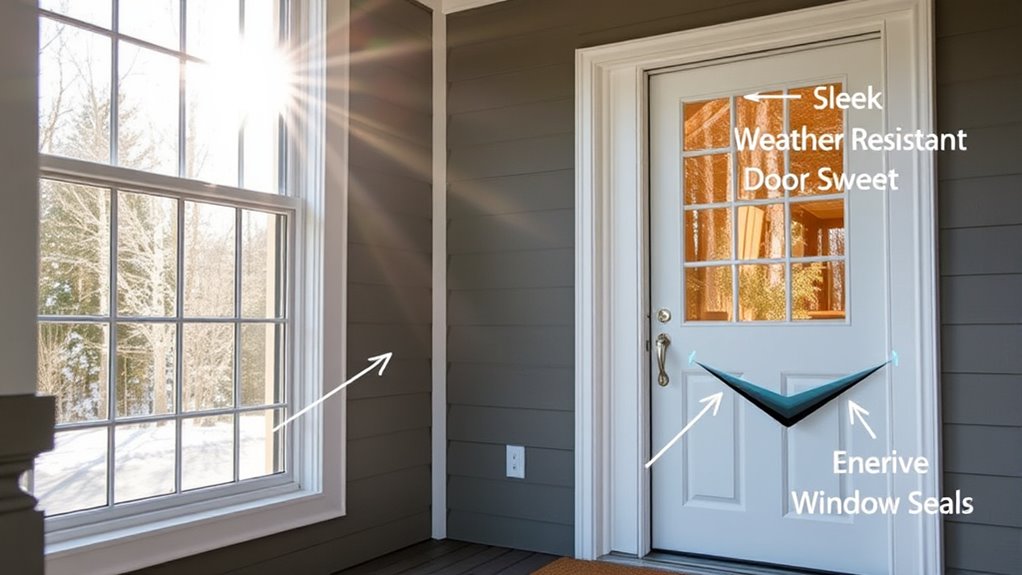
Installing energy-efficient windows and door sweeps is a straightforward way to considerably reduce drafts and improve your home’s insulation. Properly chosen windows, with quality window framing, prevent heat loss through gaps and cracks. Door sweeps seal the bottom of your doors, blocking cold air from entering. When installing, make certain the window frames fit snugly within the wall openings, reducing air infiltration. Pay attention to door thresholds; upgrading them creates a tight seal and prevents drafts. Here’s what to keep in mind:
- Choose windows with low U-values for better insulation
- Select durable, weather-resistant door sweeps
- Make sure window framing is properly sealed and insulated
- Adjust door thresholds for a perfect fit
- Regularly check and maintain seals for continued efficiency
- Incorporate natural materials like wood or linen to enhance insulation and aesthetic appeal.
These steps help maximize energy savings and comfort.
Enhancing Ventilation While Minimizing Heat Escape

To improve ventilation without losing heat, you need smart design strategies that promote airflow while sealing leaks. Properly planned vents and controlled airflow can keep fresh air coming in without letting heat escape. Sealing air leaks around windows and doors is essential to maintain energy efficiency while ensuring good ventilation. Using insulation materials can further reduce heat loss and improve overall thermal retention in your space.
Ventilation Design Strategies
Effective ventilation is essential for maintaining indoor air quality, but it can also lead to unwanted heat loss if not carefully designed. To optimize airflow while conserving heat, consider strategic placement of vents, using heat recovery systems, and employing adjustable dampers. Properly designed ventilation improves air quality and controls indoor humidity, preventing mold and discomfort. Focus on these strategies:
- Installing heat exchangers to recover warmth
- Using duct insulation to reduce heat transfer
- Positioning vents near heat sources and away from drafts
- Incorporating smart controls for adjustable airflow
- Ensuring proper air exchange rates tailored to space needs
Proper ventilation design ensures that fresh air is circulated efficiently without unnecessary heat loss.
Sealing Air Leaks
Sealing air leaks is a crucial step in maintaining ventilation efficiency while minimizing heat loss. When you block gaps around windows, doors, and ducts, you improve airflow dynamics, ensuring fresh air circulates effectively without letting warmth escape. Proper sealing keeps outdoor air contaminants out, directly enhancing indoor air quality. It also prevents drafts that cause uneven heating and discomfort. Use weatherstripping, caulk, or foam sealants to close leaks precisely where air escapes. This not only conserves heat but also helps your ventilation system operate more efficiently. By controlling airflow pathways, you maintain a stable indoor environment, reducing energy costs while ensuring good air quality. Sealing air leaks is a simple yet powerful way to optimize your home’s heat retention and ventilation balance.
Smart Home Technologies for Better Climate Control

Smart home technologies offer practical solutions to improve climate control and reduce energy loss. With smart thermostats, you can easily adjust your home’s temperature for ideal comfort while saving energy. Automated blinds work by blocking heat gain during hot days or letting in warmth during colder periods, enhancing insulation. These tools work together to create a more efficient climate system.
Consider these benefits:
- Precise temperature management
- Reduced heating and cooling costs
- Enhanced comfort with minimal effort
- Adaptive responses to weather changes
- Increased energy efficiency and sustainability
Creating a Long-Term Maintenance and Upgrade Plan

To guarantee your wind and heat loss improvements continue to perform at their best, it’s essential to develop a long-term maintenance and upgrade plan. Regular insulation maintenance helps ensure your insulation remains effective, preventing drafts and heat escape. Schedule inspections to identify and repair any damage promptly. Incorporate outdoor shading upgrades, like adjustable awnings or screens, to adapt to seasonal changes and reduce heat gain. Over time, consider upgrading to more energy-efficient materials or smarter shading systems to enhance performance. Keep track of maintenance activities and upgrade opportunities, adjusting your plan as your home evolves. This proactive approach minimizes energy loss, extends the lifespan of your improvements, and keeps your home comfortable year-round.
Frequently Asked Questions
How Can I Identify Hidden Drafts in Hard-To-Reach Areas?
You can identify hidden drafts in hard-to-reach areas by performing a candle test—move a lit candle around suspect spots and watch for flickering. For more precise detection, use an insulation probe to check for gaps or insulation issues behind walls or in tight spaces. These methods help you spot drafts effectively, even in tricky spots, so you can seal them up and improve your home’s energy efficiency.
What Are the Most Cost-Effective Upgrades for Extreme Cold Climates?
In extreme cold climates, you should prioritize cost-effective upgrades like adding insulation materials such as spray foam or fiberglass to walls and attics. An energy audit helps identify key areas for improvement. Sealing leaks around windows and doors, along with upgrading to energy-efficient windows, also boosts efficiency. These steps markedly reduce heat loss without breaking the bank, keeping your home warmer and more comfortable during harsh winters.
How Often Should I Recheck and Replace Weatherstripping Seals?
You should recheck and replace your weatherstripping seals at least once a year during seasonal maintenance, especially before winter hits. Over time, sealant durability wanes, and gaps can appear, making your home vulnerable to cold drafts. If you notice cracks, tears, or drafts, don’t delay—replacing seals now is vital. Regular inspections ensure your seals stay airtight, saving energy and keeping your home cozy through even the harshest winters.
Can Smart Thermostats Significantly Reduce Heat Loss?
Yes, a smart thermostat can considerably improve heat efficiency by optimizing your heating schedule and adjusting the temperature based on your habits. It reduces heat loss by preventing unnecessary heating when you’re away or asleep. With features like remote control and real-time energy monitoring, a smart thermostat helps you maintain a comfortable temperature while lowering energy waste, ultimately saving you money and increasing overall heat efficiency in your home.
What Safety Precautions Are Needed When Installing New Insulation?
You should prioritize insulation safety and follow installation precautions to avoid hazards. Always wear protective gear like gloves, goggles, and a mask to prevent irritation from materials. Guarantee proper ventilation in the area to avoid inhaling dust or fumes. Turn off power if working near electrical wiring, and read manufacturer instructions carefully. Taking these steps keeps you safe and ensures your insulation is installed correctly and effectively.
Conclusion
Did you know that sealing leaks and upgrading insulation can cut your home’s heat loss by up to 30%? By following these simple steps, you’ll not only save money on energy bills but also create a more comfortable, cozy living space. Taking proactive measures today means fewer drafts, warmer winters, and a greener home tomorrow. Start your upgrades now—your comfort and wallet will thank you for it.
